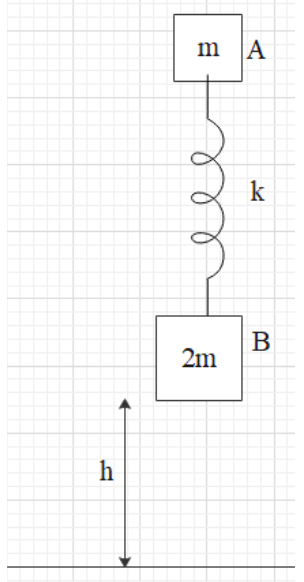
What will be the minimum height $h$ from which the system should be released when the spring is un stretched because of that after a perfectly inelastic collision $\left( e=0 \right)$ with the ground, $B$ will be lifted off the ground$\left( \text{spring constant}=k \right)$.

$\begin{align}
& A.\dfrac{mg}{2k} \\
& B.\dfrac{4mg}{k} \\
& C.\dfrac{mg}{4k} \\
& D.\dfrac{2mg}{k} \\
\end{align}$

Answer
463.2k+ views
Hint: The velocity can be found by taking the square root of the product of twice the acceleration due to gravity and height of the system. Apply the conservation of energy equation in this system and substitute the equation of velocity in it. Simplifying this equation will give the value of height. This will help you in answering this question.
Complete step by step answer:
The velocity can be found by taking the square root of the product of twice the acceleration due to gravity and height of the system. That is we can write that,
$u=\sqrt{2gh}$
In order to lift the block $B$, the extension in the spring, $x$ can be written as,
$x=\dfrac{2mg}{k}$
By the method of conservation of energy we can write that,
$0-\dfrac{1}{2}m{{u}^{2}}=-mgx-\dfrac{1}{2}k{{x}^{2}}$
The extension in the spring can be substituted in this equation as,
$\dfrac{1}{2}m{{u}^{2}}=mg\times \dfrac{2mg}{k}+\dfrac{1}{2}k{{\left( \dfrac{2mg}{k} \right)}^{2}}$
Rearranging this equation and then simplifying it can be shown as,
$\dfrac{1}{2}m{{u}^{2}}=\dfrac{2{{m}^{2}}{{g}^{2}}}{k}+\dfrac{2{{m}^{2}}{{g}^{2}}}{k}=\dfrac{4{{m}^{2}}{{g}^{2}}}{k}$
Substituting the value of the velocity in this equation can be shown as,
$\begin{align}
& \dfrac{1}{2}m\times 2gh=\dfrac{2{{m}^{2}}{{g}^{2}}}{k}+\dfrac{2{{m}^{2}}{{g}^{2}}}{k}=\dfrac{4{{m}^{2}}{{g}^{2}}}{k} \\
& \therefore h=\dfrac{4mg}{k} \\
\end{align}$
Therefore the height from which the system should be released when the spring is un-stretched because of that after a perfectly inelastic collision with the ground, $B$ will be lifted off the ground.
So, the correct answer is “Option B”.
Note: According to the theorem of conservation of energy, the energy cannot be created by ourselves and cannot be destroyed by ourselves. It can only be transferred one form to any other form. That is in rotating a fan the electrical energy has been converted to mechanical energy. This way only the conversion of energy is only possible.
Complete step by step answer:
The velocity can be found by taking the square root of the product of twice the acceleration due to gravity and height of the system. That is we can write that,
$u=\sqrt{2gh}$
In order to lift the block $B$, the extension in the spring, $x$ can be written as,
$x=\dfrac{2mg}{k}$
By the method of conservation of energy we can write that,
$0-\dfrac{1}{2}m{{u}^{2}}=-mgx-\dfrac{1}{2}k{{x}^{2}}$
The extension in the spring can be substituted in this equation as,
$\dfrac{1}{2}m{{u}^{2}}=mg\times \dfrac{2mg}{k}+\dfrac{1}{2}k{{\left( \dfrac{2mg}{k} \right)}^{2}}$
Rearranging this equation and then simplifying it can be shown as,
$\dfrac{1}{2}m{{u}^{2}}=\dfrac{2{{m}^{2}}{{g}^{2}}}{k}+\dfrac{2{{m}^{2}}{{g}^{2}}}{k}=\dfrac{4{{m}^{2}}{{g}^{2}}}{k}$
Substituting the value of the velocity in this equation can be shown as,
$\begin{align}
& \dfrac{1}{2}m\times 2gh=\dfrac{2{{m}^{2}}{{g}^{2}}}{k}+\dfrac{2{{m}^{2}}{{g}^{2}}}{k}=\dfrac{4{{m}^{2}}{{g}^{2}}}{k} \\
& \therefore h=\dfrac{4mg}{k} \\
\end{align}$
Therefore the height from which the system should be released when the spring is un-stretched because of that after a perfectly inelastic collision with the ground, $B$ will be lifted off the ground.
So, the correct answer is “Option B”.
Note: According to the theorem of conservation of energy, the energy cannot be created by ourselves and cannot be destroyed by ourselves. It can only be transferred one form to any other form. That is in rotating a fan the electrical energy has been converted to mechanical energy. This way only the conversion of energy is only possible.
Recently Updated Pages
Glucose when reduced with HI and red Phosphorus gives class 11 chemistry CBSE

The highest possible oxidation states of Uranium and class 11 chemistry CBSE

Find the value of x if the mode of the following data class 11 maths CBSE

Which of the following can be used in the Friedel Crafts class 11 chemistry CBSE

A sphere of mass 40 kg is attracted by a second sphere class 11 physics CBSE

Statement I Reactivity of aluminium decreases when class 11 chemistry CBSE

Trending doubts
10 examples of friction in our daily life

The correct order of melting point of 14th group elements class 11 chemistry CBSE

Difference Between Prokaryotic Cells and Eukaryotic Cells

One Metric ton is equal to kg A 10000 B 1000 C 100 class 11 physics CBSE

State and prove Bernoullis theorem class 11 physics CBSE

What organs are located on the left side of your body class 11 biology CBSE




